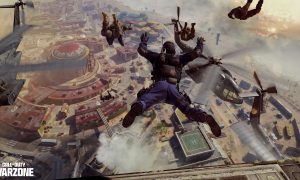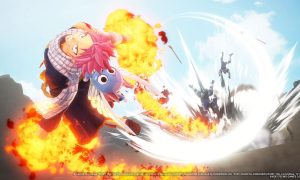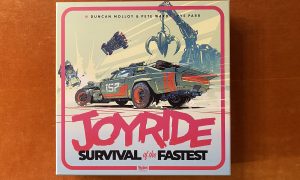The thought of an America under siege is not a new one – John Milius brought us a cold war cautionary tale where a small town is overrun by Russian forces, leaving only a band of high school students to take on the mantle of guerrilla fighters to repel them – you’ll know it as Red Dawn. Milius is back at the helm in familiar territory, but this time it is far, far worse. In the near future, as Kim Jong Il passes away his son Kim Jung-un rises to power. Uniting Korea through war, soon his sights are set on the heart of Europe, and eventually even the United States. Using a well placed EMP, they blinded the sleeping giant, giving them the chance to not only occupy but completely sieze the United States.
As we join our main character in the year 2027, the United States is very much under the rule of the Korean People’s Army. Curfews are in place, common citizens are corralled like cattle, innocents are shot in the streets for any level of insurrection, and it hardly even looks like the America that we know and love. As the morning sun rises in Montrose Colorado we join our protagonist Jacobs in his run down humble home. A knock on the door quickly turns into an abduction as two KPA soldiers and an officer pop by to question your loyalty to the cause. Herded onto a repurposed school bus, our destiny seems sealed until fate (and a Semi) intervened.
Saved by American Resistance members Morgan and Rianna, the game quickly pushes you from retired pilot turned civilian into ground soldier and guerrilla fighter. Making it back to the camp it doesn’t take but a few moments to see exactly where America stands – these ‘soldiers’ are more ex-soldiers, ex-police officers, mechanics, small children, and scared citizens than hardened military people. The young country of America faces its second revolution and once again the stakes couldn’t be higher.
If you can hear this, you are the resistance
What immediately speaks to me about Homefront is that every bit of this is absolutely possible. Speculative fiction about the demise of America isn’t new, but it hasn’t been done well – that just changed. Fighting through the suburbs of America, seeing familiar restauraunts and venues in smouldered ruins around you, and seeing first hand the results of guerrilla fighting against a well organized army drew me in completely. Surprisingly, it actually wasn’t the graphics that pulled me in, but the fire mechanics. I usually start off telling you about what you can see, but this time it’s about the bullets.
Other shooters (even the big popular ones) feel all sorts of wrong. The weapons sound correct, and are often motion and sound captured from the real things. The problem begins when the bullets start hitting targets. In nearly all other shooters you can empty an entire clip into an unarmored enemy and have them shrug it off like you threw a box of Q-Tips at them. In Homefront I actually found myself using real military tactics I’d used in the field – three round bursts to the chest will take down anyone not wearing body armor. For those wearing armor, two three round bursts will set them on their ass. A shot to the head is immediatley fatal, and clipping an enemy in the leg will leave them less likely to sprint around the map like a Track and Field star. Put simply, Kaos studios nailed the gun mechanics perfectly – it hasn’t been better than this in any game I’ve played to date. High praise indeed given that shooters are kinda my thing.
Graphically you know pretty much what you are in for with Homefront – it uses the Unreal engine. Since we are talking about places in middle America, the challenge wasn’t to make a compelling fictional map, but making a map that could be just outside your window. Serving as fuel for your anger, you’ll duck into bombed out White Castle burger joints (we called em Sweat Burgers when I lived in Michigan!) and even a Tiger Direct warehouse. Jumping over the picket fences of our own fictional back yard coupled with a great physics engine really adds to the debris-filled atmosphere. Nowhere will this strike home more than a visit to a nearby baseball field. I won’t ruin the moment, but it is one of the more shocking and somber moments without needing to resort to slow motion and forced shock reactions.
I have to take a moment to talk about the lighting engine in this game. Great lighting is something that the Unreal engine does well, but the guys at Kaos really took it to the next level. While going up a stairwell I had to pause and marvel at the brightness of the overhead lights, the shadows it cast, and the very real way that it affected our eyes. It’s the little things, and they got this little thing right.
On the flip of that coin, we have the character models. While the armor and weapons are extremely detailed, the facial models and NPC animations bounce between great and jarring. Odd animations coupled with an AI that occasionally wants to take cover by bouncing between two explosive barrels does pull you out of the moment a bit.
The environments in Homefront aren’t all middle American suburbs – you’ll also find yourself on the outskirts, racing to other towns to try to recruit other soldiers, and even taking to the skies before reaching the final set piece of the game. Again, I won’t ruin the moment, but after about 7 hours the game does seem to end on an obvious and abrupt sequel note. In a similar way, the gameplay is varied – sometimes you’ll be bounding through the cities, other times you’ll take control of the mighty Goliath (a 6 wheeled .50 cal wielding tornado of destruction), and even going completely stealth for one mission. The game never lets you settle into a groove for too long before popping you back onto your toes once again.
Go Wolverines!
While there are a few homages to Apocalypse Now and Red Dawn, there is a set of collectables to pick up throughout the game. In various locations around the game world there are ‘old’ (but in the future for us) articles that give a bit more backstory to the occupation of the United States. Sometimes they are clips from a newspaper article talking about the events prior to the war, other times they are propaganda used against our own citizenry. There are a total of 60 of these items to collect and they fill in much of the backstory for the game and moments preceeding. As far as collectables go, it is a little more compelling than finding dogtags or McGuffin-style “Intel” items.
Beyond the reasonable amount of single-player game here, ther is a robust multiplayer component. Sporting 32 players on both the PS3 and 360, the game is set up for large scale warfare. Utilizing a system similar to what we’ve seen in classic games like CounterStrike, the game rewards you for doing well allowing you to move from boots on the ground to jeeps, APCs, tanks, remote controlled drones, weapon upgrades, and even the devastating Apache helicopter. Sure, there is a team deathmatch type mode, but honestly that’s been done to death – the real action here is in the unique mode called Battle Commander.
In Battle Commander, an AI general watches over your team and their progress. As the battle rages on, the Battle Commander will begin to assign dynamic missions based on ever-shifting objectives. If another player is on a killing spree, the Battle Commander will assign a star value to their head, earning you a ton of Battle Points should you take them out. A single star mission is a lower priority mission that will net you a few Battle Points (more on that in a moment), and is usually only assigned to a single player. As those star levels rise towards 5, more and more players will be assigned the same
Ron Burke is the Editor in Chief for Gaming Trend. Currently living in Fort Worth, Texas, Ron is an old-school gamer who enjoys CRPGs, action/adventure, platformers, music games, and has recently gotten into tabletop gaming.
Ron is also a fourth degree black belt, with a Master's rank in Matsumura Seito Shōrin-ryū, Moo Duk Kwan Tang Soo Do, Universal Tang Soo Do Alliance, and International Tang Soo Do Federation. He also holds ranks in several other styles in his search to be a well-rounded fighter.
Ron has been married to Gaming Trend Editor, Laura Burke, for 28 years. They have three dogs - Pazuzu (Irish Terrier), Atë, and Calliope (both Australian Kelpie/Pit Bull mixes), and an Axolotl named Dagon!

See below for our list of partners and affiliates:
























